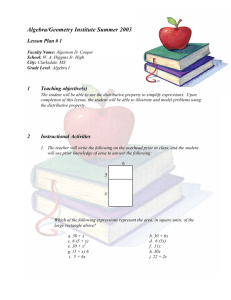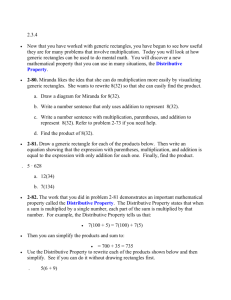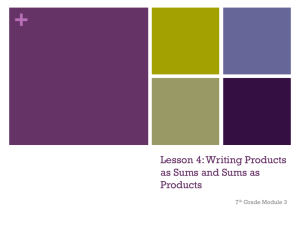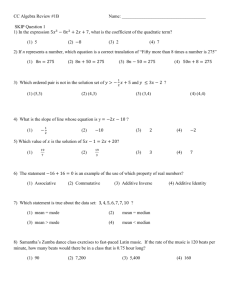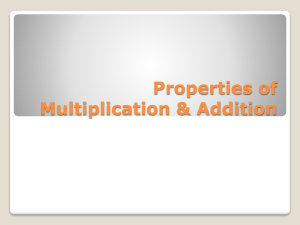Algebra 1B - TeacherWeb
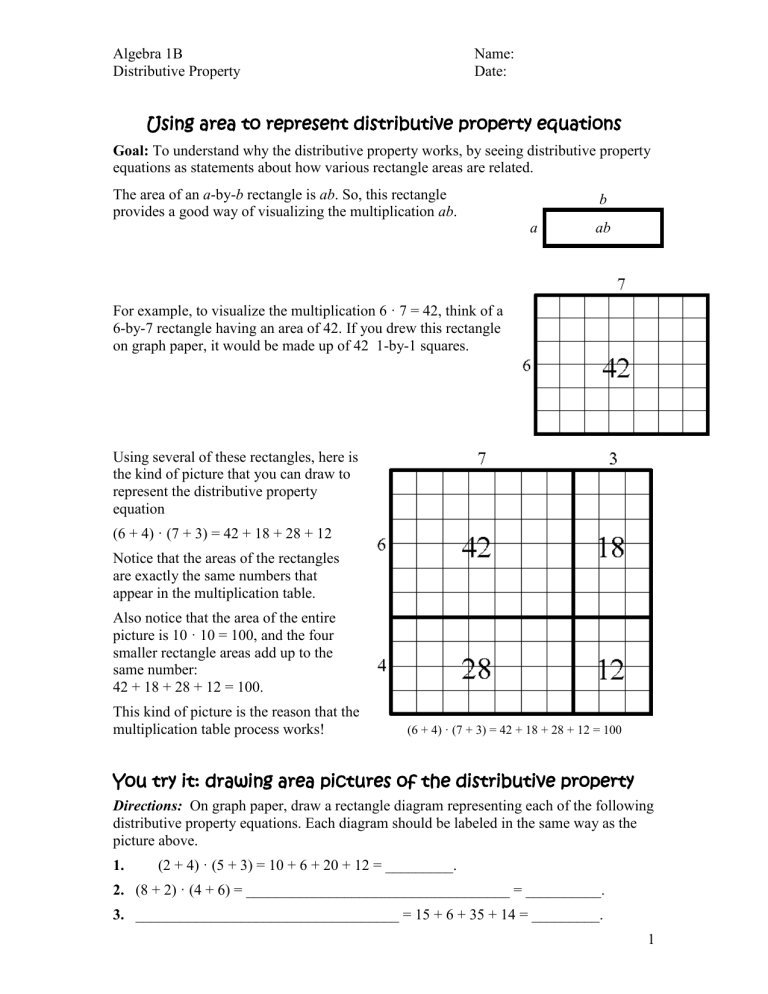
Algebra 1B
Distributive Property
Name:
Date:
Using area to represent distributive property equations
Goal: To understand why the distributive property works, by seeing distributive property equations as statements about how various rectangle areas are related.
The area of an a -byb rectangle is ab . So, this rectangle provides a good way of visualizing the multiplication ab .
For example, to visualize the multiplication 6 · 7 = 42, think of a
6-by-7 rectangle having an area of 42. If you drew this rectangle on graph paper, it would be made up of 42 1-by-1 squares.
Using several of these rectangles, here is the kind of picture that you can draw to represent the distributive property equation
(6 + 4) · (7 + 3) = 42 + 18 + 28 + 12
Notice that the areas of the rectangles are exactly the same numbers that appear in the multiplication table.
Also notice that the area of the entire picture is 10 · 10 = 100, and the four smaller rectangle areas add up to the same number:
42 + 18 + 28 + 12 = 100.
This kind of picture is the reason that the multiplication table process works! a b ab
(6 + 4) · (7 + 3) = 42 + 18 + 28 + 12 = 100
You try it: drawing area pictures of the distributive property
Directions: On graph paper, draw a rectangle diagram representing each of the following distributive property equations. Each diagram should be labeled in the same way as the picture above.
1.
(2 + 4) · (5 + 3) = 10 + 6 + 20 + 12 = _________.
2.
(8 + 2) · (4 + 6) = ___________________________________ = __________.
3.
___________________________________ = 15 + 6 + 35 + 14 = _________.
1
Distributive Property
Goal: To learn how to perform more complicated versions of the distributive property by using the algebra tiles.
Idea #1
2 nd Step:
3 rd Step:
You have previously worked with simple versions of the distributive property, such as a · ( b + c ) = ab + ac
But what would you do with a more complicated multiplication, such as
( x + 3
) · ( x + 4) = ?
Think of this as an area problem…
What do you multiply together to get the area of a rectangle?
What does (x + 3) represent?
What does (x + 4) represent?
Use your Lab Gear to find the area of a rectangle with _______________(x + 3) and (x + 4).
1 st Step: Use your algebra lab gear to represent the rectangle with the above dimensions.
(Sketch below)
List the tiles used to fill in the rectangle.
Simplify by combining ‘like terms.’
2
Using “algebra lab gear” to represent area
You try it
You have been given a set of algebra lab gear to use during this class. IMPORTANT:
You are responsible for putting all of your tiles back in the bag at the end of the period.
Directions: Find an algebra lab gear arrangement that represents each of the following distributive property equations. Then, sketch a picture of your lab gear arrangement on paper.
1.
( x + 4) · ( x + 2) = x 2 + 2 x + 4 x + 8
2.
(2 x + 2) · (3 x + 1) = 6 x 2 + 2 x + 6 x + 2
3.
2 x · ( x + 3 + 1) = 2 x
2
+ 6 x + 2 x
3
Same directions as before: Find an algebra lab gear arrangement that represents each of the following distributive property equations. Then, sketch a picture of your tile arrangement on paper and complete the equation.
4.
( x + 5) · ( x + 1) = _______________________ 5. (2 x + 1) · ( x + 4) =_______________________
Hint for 6 and 7: Start with all the tiles you will need. Find a way to arrange them to form a big rectangle.
6.
_________________________ = x
2
+ 4 x + 3 7.
_________________________ = x
2
+ 4 x + 4
8.
3 x · ( x + 2) = ________________________ 9.
(2 x + 2) · (3 x + 1) =_____________________
4
Practice:
10.
Calculate each of these products by using and sketching the lab gear.
Then, write and draw your result as an equation (don’t forget to combine like terms). a.
Calculate ( x + 2) · (x + 3) b.
Calculate ( 4 + x
) · (
4 + x ) c.
Calculate ( x + 5) · (6 + x )
5



